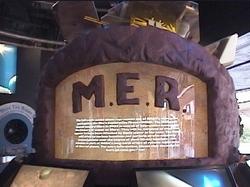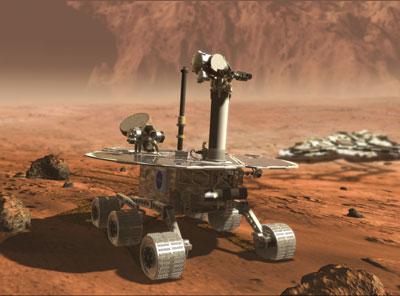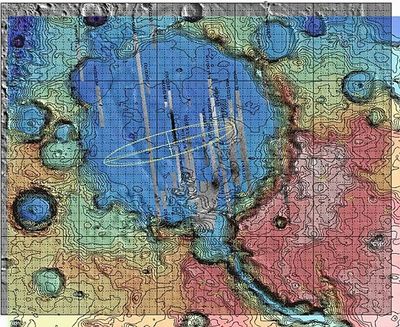Sat, Apr 12, 2003
Covering Twice The Ground
 If NASA has its way, not one, but two rovers will
soon be roaming the Red Planet, investigating areas that might have
once held bodies of water.
If NASA has its way, not one, but two rovers will
soon be roaming the Red Planet, investigating areas that might have
once held bodies of water.
NASA managers announced the two landing sites for the Mars
Exploration Rovers (MERs) Friday, saying both sites were
scientifically compelling. Four prospects were under consideration
and NASA made its final decision based not only on scientific
allure, but spacecraft technical concerns, said space science
program chief Ed Weiler.
"In choosing where to go, we need to balance science value with
engineering safety considerations," said Weiler. The first rover,
scheduled for launch on May 30, will be directed to Gusev Crater,
located 15 degrees south of Mars' equator (see map, bottom). The
second robotic scout, slated for liftoff on June 25, is targeted to
land at Meridiani Planum, which features rich deposits of gray
hematite, an iron oxide mineral associated with water. Meridiani
Planum is about 2 degrees south of the equator and halfway around
the planet from Gusev Crater.

Doing The Job Before The Lights Go Out
The first rover should reach its landing site on Jan. 4 and the
second on Jan. 25. Each is expected to last for about three months
before dust blankets the rovers' solar arrays, cutting off their
power. The rovers' masts will carry remote sensing instruments,
including high-resolution color cameras and infrared spectrometers
for studying the minerals in rocks and soil. The rovers also will
be equipped with a microscopic imager to see micron-size particles
and textures, an alpha-particle/x-ray spectrometer to determine
what elements the samples contain, and a Moessbauer spectrometer
for determining the mineralogy of iron-bearing rocks.

Each rover will carry a rock abrasion tool, similar to a
geologist's rock hammer, to remove weathered surfaces from rocks
and expose their interiors for analysis. The overall scientific
focus of the mission is to investigate what role water played on
Mars and to determine how suitable the conditions would have been
for life, said Cornell University's Steve Squyres, a principal
investigator.
More News
He Attempted To Restart The Engine Three Times. On The Third Restart Attempt, He Noticed That Flames Were Coming Out From The Right Wing Near The Fuel Cap Analysis: The pilot repor>[...]
Make Sure You NEVER Miss A New Story From Aero-News Network Do you ever feel like you never see posts from a certain person or page on Facebook or Instagram? Here’s how you c>[...]
From 2009 (YouTube Edition): Leading Air Show Performers Give Their Best Advice for Newcomers On December 6th through December 9th, the Paris Las Vegas Hotel hosted over 1,500 air >[...]
Aero Linx: NASA ASRS ASRS captures confidential reports, analyzes the resulting aviation safety data, and disseminates vital information to the aviation community. The ASRS is an i>[...]
“For our inaugural Pylon Racing Seminar in Roswell, we were thrilled to certify 60 pilots across our six closed-course pylon race classes. Not only did this year’s PRS >[...]
 NTSB Final Report: Rutan Long-EZ
NTSB Final Report: Rutan Long-EZ ANN FAQ: Turn On Post Notifications
ANN FAQ: Turn On Post Notifications Classic Aero-TV: ICAS Perspectives - Advice for New Air Show Performers
Classic Aero-TV: ICAS Perspectives - Advice for New Air Show Performers ANN's Daily Aero-Linx (06.28.25)
ANN's Daily Aero-Linx (06.28.25) Aero-News: Quote of the Day (06.28.25)
Aero-News: Quote of the Day (06.28.25)





